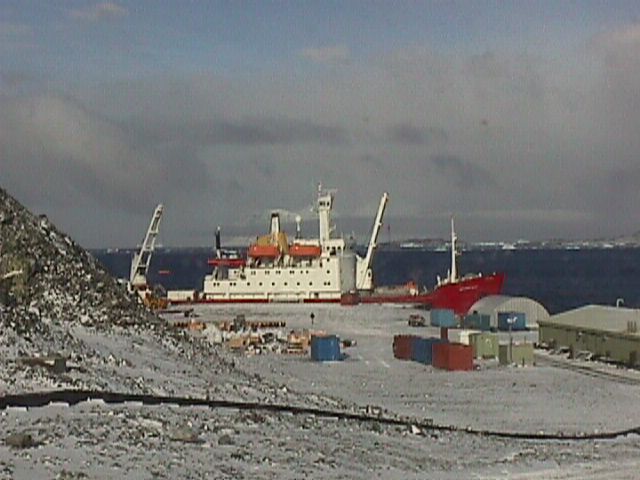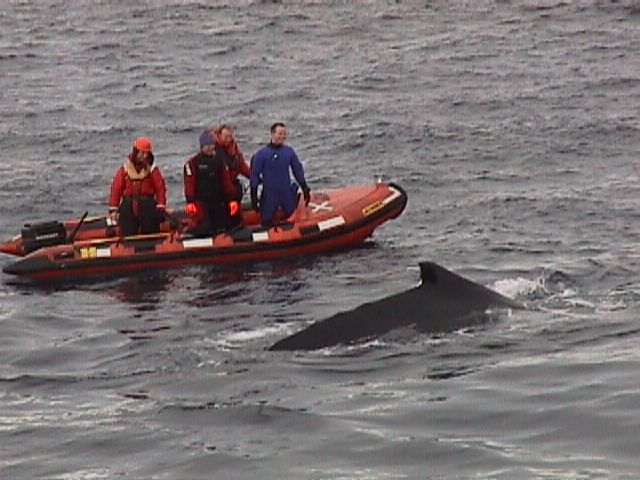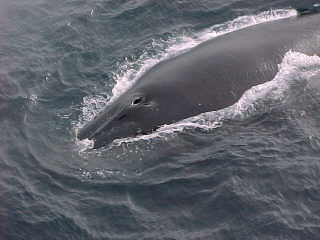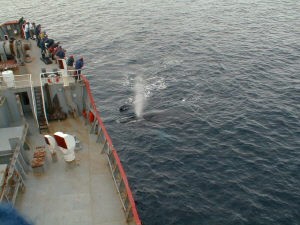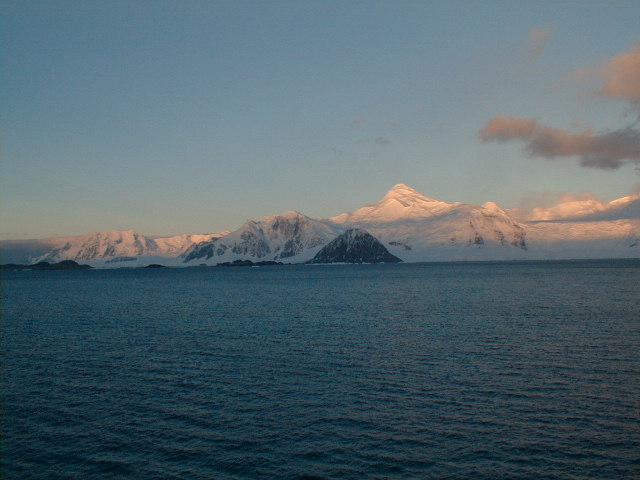| Date | Sunday 21st March 1999 |
| Time | 1200 (UTC-3) |
| Position | Latitude 64°46' South
Longitude 064°03' West At anchor in Arthur Harbor, Palmer Station. |
| Next destination | Signy Base |
| ETA | 27th March 1999 |
| Total distance | 22148.1 Nautical Miles
(Since departing Grimsby on 17th October 1998) |
| Current weather | Overcast with light snow |
| Wind | Light airs |
| Sea state | Flat calm |
| Air temperature | 0.6°C |
| Sea temperature | 1.2°C |
Ship's
track - Updated every six hours from the weather observations sent
to Bracknell weather centre - direct from BAS
homepage.
Summary
Only a few hours after completing last weeks update the Bransfield arrived at Adelaide Island and Rothera Base. On approaching the Biscoe Wharf the weather seemed fair, although the wind was blowing off-shore at about 20 knots. Awaiting our arrival were a large group of staff from the base, some to help secure the ship to the wharf, others to photograph the ships arrival. As the bow approached the wharf, the wind started to increase and a snow shower approached so that as the lines were being put ashore it was as if a blizzard had come to greet us. The wind direction was such that it was blowing us off of the wharf and this was making the whole operation very difficult, especially as the wind was now gusting at up to 35 knots. Once the Bransfield was safely secure alongside the wharf, cargo operations started without any delay, as there was much work to be done and only a very short time allowed for the completion of the discharge cargo and back-loading of outgoing cargo and waste.
The weather was not going to improve during our stay and much of the cargo operations were completed in driving snow and the wind never seemed to drop below 20 knots. On Wednesday three of the mooring ropes parted and had to be replaced to ensure that the vessel remained secure. Cargo work continued up to 2100 Hrs on Thursday when the hatches were closed in preparation for departure the following morning.
One of the enjoyable aspects to Rothera is that it is possible to walk to the base in a matter of minutes, there is no need to wait for a boat to run, as at Signy and Bird Island, and you don't need to hitch a lift in a passing snowcat, as at Halley. On Monday evening the base opened its Post Office for those wanting to send mail and also sold a variety of t-shirts for those wanting souvenirs. The bars on the ship and the base were also open in the evenings and everyone had the chance to visit and look around either the base or the ship.
This is the worst weather that I have seen at Rothera for a relief, normally the weather is lovely with the mountains basked in sunlight and there are numerous walks around the base area, many with fine views and excellent photographic potential. The runway looked rather forlorn, as with the five aircraft now away from the base all the runway lights had 45 gallon drums sitting over them to provide protection throughout the coming winter, and the constant snow had started to settle as winter made its approach.
Thursday morning turned out to be nice and bright and the Bransfield sailed at 0800, just as the sun was rising and basking the surrounding mountains in a lovely glow and probably the best weather we had seen since arriving. There was still a wind of some 20 knots but at least no snow for a change. All the wintering staff came down to wave the ship off and say their final goodbys to those leaving them. Although this is the beginning of the winter period for the base staff, there is still one final ship visit as the James Clark Ross is due to call in sometime during the next few weeks as it undertakes a science cruise in the area.
The Bransfield moved away and around the south end of Adelaide Island before turning north up the western side of the island. Once away from the shelter and in open waters the full force of the wind hit us and as the day progressed so the weather got worse and by 1800 the wind was blowing at Force 9 and the ship was pitching and rolling easily. Within a few hours the wind had backed off and was down to a Force 5 and the night was not too uncomfortable. One of the tasks on our journey north is to deploy divers at selected sites to undertake work as part of the 'Geneflow' experiment (see the article later in this page) and initially the divers had hoped to make their first dive at Detaille Island, which is located between the northern end of Adelaide Island and the Antarctic Peninsula, and approached via Matha Strait. In the early hours of Friday morning, with the weather having not improved greatly, the decision was made to abandon this dive site and continue north to Vernadsky to collect Vicky Auld who had been dropped off last week and, if the weather was good enough attempt to do some dives in the vicinity of Vernadsky Base and the surrounding islands.
Saturday morning and the Bransfield was in position in the Penola Straight, just off of the Meek Channel, to deploy the workboat Erebus to make the trip to Vernadsky base and collect Vicky and the equipment that she was removing (an Automatic Weather Station which is to be deployed elsewhere next season). The entire Ukranian wintering team was at the jetty to say good-bye and soon the Erebus was back on board. The weather was showing signs of improvement and so the Bransfield moved round to the anchorage off of Drum Rock (so called because it has a drum on top of it as a reference point!) and the anchor was dropped. The weather did improve and soon the Erebus was back in the water along with two inflatable boats to carry the diving team consisting of six divers and a terrestrial biologist with an assistant to the first site. The dive was to take place in Meek Channel, just off Galindez Island, and the terrestrial team would work on the island. Each pair of divers would be able to dive to a maximum depth of 15m for 30 minutes.
Whilst this was happening and just before lunchtime two humpback whales appeared on the scene and remained with us for over three hours. At times the whales were so close that the spray from their 'blows' could be felt and everyone got the chance to take some very good close up photographs. The whales seemed very interested in us and spent a lot of time just off of the bow of Bransfield and when the divers returned with their samples and where getting the boats back on board, the whales went to say 'hello' and have a close look at them. At no time did they seem the least concerned with either the presence of the Bransfield or the boats. Once the divers had recharged their bottles and spent the required time out of the water the boats were again lowered and this time the teams went across to Irizar Island for a second set of sampling, again accompanied by the terrestrial team. As soon as the divers were back on board with their specimens it was time to weigh anchor and continue north, through the Lemaire Channel, to spend the night just off of Anvers Island before proceeding into Arthur Harbor to visit the American base, Palmer Station.
Sunday morning was dull, overcast and snowing. Bransfield approached
Arthur Harbor at about 0715 and the ship was anchored for 0800. 'Tula'
was launched and everyone that wished to visit the American station managed
to get some time ashore and have a look around the base. Ron Nugent, the
Station Manager, and Alexandra Brown, Administrative Co-ordinator, made
us all very welcome. Several members from the station came out for a look
around the ship and at 1200 the anchor was weighed and the ship headed
north once again and headed towards the Neumayer Channel and the next dive
site.
Penguins at Port Lockroy - by Nigel Milius
Goudier Island, Port Lockroy, has a breeding population of some 700 pairs of Gentoo Penguins in addition to accommodating the UK's oldest base on the peninsula. Several relics remain from the whaling days earlier in the century, the scenery is superb and it's also a good anchorage for ships. In summer a shop and Post Office are operated by the Antarctic Heritage Trust, so it is not too surprising that it's also the most visited sight in Antarctica, something over 5,500 visitors this season.
Due to this large number of visitors it is an excellent, if not unique, site to look at the impact of tourism on the penguin colony, especially so as one end of the island remains little visited, thus acting as a control area. This was realised two years ago when the base was first manned in its present form and a project was set up to look at the breeding success in different parts of the island.
The first thing that was immediately apparent when I arrived at the end of November was that the Gentoos had laid earlier than in the previous two seasons by around a fortnight. Indeed, it seemed that some birds had already lost their eggs to patrolling Skuas and Sheathbills. The extent of this predation became apparent over the next two weeks as nests became abandoned at a rate that was making me wonder if I'd have any penguins left to study by the New Year, an area of about 30 nests just behind the base for example, was wiped out totally. Other studies revealed that the cause was possibly a shortage of food, with birds spending up to six days away from the nests on feeding trips (less than 24 hours being more the norm). Presumably a hungry bird would be less able to defend the eggs, and a hungry Skua would be more determined to press home an attack.
Almost overnight in mid-December, just as the first chicks were hatching, fortunes changed completely. My small number of marked birds started to change over much more regularly at the nest and the pair of Brown Skuas responsible for a large part of the carnage vanished. Over the next two months as the chicks developed (half that time being guarded on the nest by the parents, then venturing further and further from the nest as they grew older and bolder, and eventually forming loose creches) a few succumbed to one thing or another but losses were fairly minimal. The Brown Skuas may have disappeared, but several of the slightly smaller, and less ruthless, South Polar Skuas remained, and they weren't going to miss the chance to pick off the sick or weak.
Before we knew it, it was approaching the end of the season and there was some entertainment to be had watching the chicks learning to swim, the "porpoiseing class" particularly saw some spectacular belly flops! At this time too, the young penguins met their next hazard. We'd not seen many until then, but early March saw the arrival of Leopard Seals. It was both a little sad and a little gruesome, although also quite spectacular, to see these powerful creatures munch there way through 8-10 penguins a day between them, but they have to live too, and that's how they do it.
Although virtually impossible to count accurately, some of the 606 chicks
which reached the creche stage will have survived all these hazards and
some of those will survive to return to breed in a couple of years time.
As for the effect of lots of well behaved visitors, the most obvious impact
was that birds close to the base just ignored people! Perhaps a lot of
visitors to a site is actually less stressful than just a few?
Bransfield Geneflow Diving Programme - What's it all
about? - by Si Brockington
Antarctica is famous for many reasons, one of the most poignant of which is the climatic harshness of the continent. Antarctica is a desert in that the cold temperatures cause all the available water to be frozen and therefore not available to be used by living creatures.....there are no large land animals or plants living in Antarctica. Although there are a few terrestrial mites and springtails living in association with sparse clumps of mosses or lichens these land animals are very much at the limit of their distributions in the more northerly extremes of Antarctica. We're all very familiar with the tragic end to the early exploratory visits to this continent - it is a difficult place indeed to scratch out a life.
But...this is not the complete story! Antarctica is surrounded by the vast Southern Ocean. The temperature of this ocean is very cold, varying between +1.5 and -1.8°C (seawater can drop below zero without freezing due to its salt content) depending on the time of year and the latitude. However one of the most remarkable things about the Southern Ocean are the number of animals which are to be found living on its shores. Although the upper regions of the seashore are bare of animal & plant life this is only due to the abrasive scouring action of the icebergs in summer and the fast ice foot moving up and down with the tidal cycle in winter. Descending down to only 10 or 15 metres below the sea's surface shows that there is a tremendous biomass and diversity of animals living in these waters - there are as many types of animals living in these waters as you would expect to find in the waters around U.K. Sea urchins, sea-stars, snails, fish, featherstars, sea-squirts to name but a few are all common bottom dwellers. Clearly the temperature of the water is no hindrance to either life in general or evolution since many of these animals are endemic to (that is, live only in) Antarctica. Nevertheless, although many of these animals may look very similar to those found in U.K. waters they do however show a number of variations in the way in which they live their lives. Slow growth rates are one of the more obvious variations: some animals may live for many many decades and these variations are often attributed either to the cold water temperature or to the fact that many of the animals depend on the annual phytoplankton bloom for their food. This bloom sends the ocean greeny brown due to its intense nature, but lasts only for a couple of months at the height of summer. For the rest of the year the animals may have to endure enforced starvation, and indeed the cold temperatures may help them do this.
So what are the reasons behind the Geneflow cruise? Another of the particular variations shown by the Antarctic animals is in the way in which they reproduce. In more northerly latitudes marine animals will often reproduce by means of an intermediate larval stage. To produce this larvae male and female animals of the same species spawn either eggs or sperm into the water at roughly the same time. The sperm fertilzes the eggs and after a short period of development a larvae is formed, and this may stay in the water column as a part of the plankton for a period ranging from hours to months depending on the species and where it is in the world. During this time it is entirely at the mercy of the ocean currents and can disperse over many miles, and this is one of the ways in which the species maintains its geographical distribution. But there is also another way of reproducing, and this is referred to as direct development. Here the female animal simply lays fertilized eggs onto rocks or algae, and these eggs develop directly into miniature adults - there is no larval stage. If the whole of the Southern hemisphere is considered there is a distinct trend towards direct development and away from larval development with increasing distance from the equator. Antarctica is not only a natural endpoint in this trend but also the most extreme example of an environment which is home to species using direct development. Scientists tend to believe this tendency to use direct development is due to either water temperature or food availability. However what we do not know is what effect the lack of a dispersal stage has upon the animals biology - without a dispersive (larval) stage we would expect animals living at geographically separate sites to show different characteristics, and this is something we can investigate using DNA genetic techniques. However before all of that we need samples, and this is the purpose the using Bransfield over the next few days. We're hoping to collect samples at sites which are separated by different geographical distances, starting with Rothera and working our way up the Peninsula to Signy. At each site we're going to collect two species - one is the common Antarctic limpet (a larval spawner), and the other is a small white topsnail called Margarella and this is a direct developer. Whilst working from a base such as Rothera provides some spectacular runs of data over time, this will be one of the first occasions where we can get data over geographical distance and as such will be very useful.
All we need now is some good weather!
Forthcoming Events
Continue with the diving programme as the ship heads to the northern end of the Antarctic Peninsula and then on to Signy.
Sunday 4th April 1999, 1200 UTC on ITV. Further coverage of the ITN visit to Antarctica on board the Bransfield.
GM0HCQ/MM QRV 14052kHz @ 2030z & 0000z
The next update will be written on Sunday 28th March 1999 and should
be published on Monday 29th March 1999.
